Solar Charger Market Research, 2032
The global solar charger market was valued at $575 million in 2022, and is projected to reach $1,849 million by 2032, growing at a CAGR of 12.5% from 2023 to 2032.
Report Key Highlighters:
The solar charger market study covers 20 countries. The research includes a segment analysis of each country in terms of value ($Million) for the projected period 2023-2032.
The study integrated high-quality data, professional opinions and analysis, and critical independent perspectives. The research approach is intended to provide a balanced view of global markets and to assist stakeholders in making educated decisions in order to achieve their most ambitious growth objectives.
Over 3,700 product literature, annual reports, industry statements, and other comparable materials from major industry participants were reviewed to gain a better understanding of the market.
The solar charger market is highly fragmented, with several players including Allpowers Industrial International, Goal Zero, letsolar, RAVPower, Renogy, Secur, Solar Frontier Europe GmbH, Solar Technology International, The NOCO Company, and YOLK.
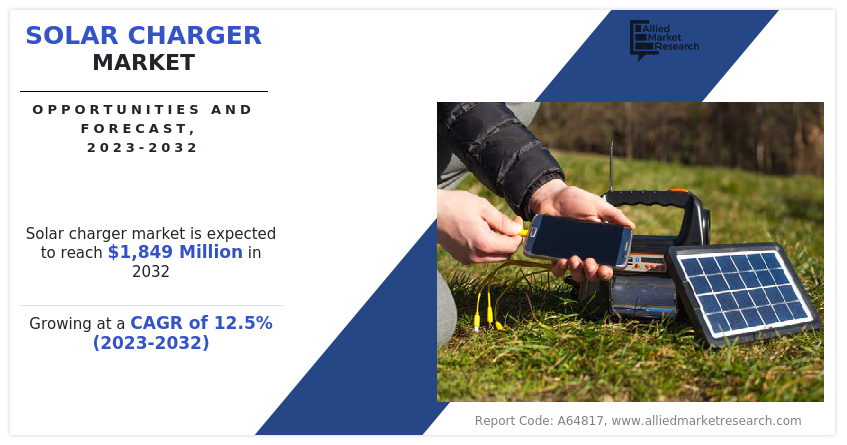
Solar chargers are devices that use solar radiation to generate electricity, which is then used to charge electronic devices including tablets, smartphones, cameras, and other portable electronics. Typically, these chargers are made of photovoltaic (PV) solar panels, which utilize light from the sun to generate power. This electricity may be used to charge devices immediately or is stored in built-in batteries. Solar chargers are ideal for travel, outdoor activities, and situations where access to traditional power sources is limited owing to their portable nature. They provide a handy way to power devices using renewable energy from the sun and offer a sustainable and environmentally friendly charging solution that reduces reliance on conventional grid electricity.
Rise in demand for renewable energy is poised to drive significant expansion in the solar charger market.
Surge in demand for renewable energy, driven by environmental awareness, government support, technological advancements, and shift towards sustainable practices, has propelled the growth of the solar charger market. According to the International Energy Agency (IEA), renewable electricity capacity additions reached an estimated 507 GW in 2023, almost 50% higher than in 2022, with continuous policy support in more than 130 countries spurring a significant change in the global growth trend. Rise in use of solar energy as a convenient and clean power source for personal electronics is one of the main factors that propels the market expansion for solar chargers. The need for efficient and sustainable charging options has increased significantly as smartphones, tablets, and other portable devices have become popular in use leading to rise in demand for solar charger market report
Solar chargers have emerged as an economically and environmentally responsible substitute for conventional charging techniques. They work by using sunlight to generate power and charge electronic gadgets. Demand for solar chargers increased as individuals become more aware of environmental problems and look for solutions to lower their carbon impact.
Government policies and actions that support clean energy solutions coexist with the global push towards the adoption of renewable energy. The International Energy Agency (IEA) is tracking the amount of money allocated by governments to support clean energy investment since 2020. The latest update of the IEA’s Government Energy Spending Tracker shows that the amount of money allocated by governments to support clean energy investment since 2020 has risen to 1.34 trillion. Governments promote the use of solar technology, especially solar chargers, by providing tax breaks, subsidies, and other benefits in many areas.
In addition to helping the renewable energy industry expand, these encouraging regulations also create an atmosphere conducive to the expansion of the solar charger market. The market experiences a significant growth as consumers gain from financial incentives and rise in awareness of the environmental advantages of solar charging. Thus, rise in demand for renewable energy is expected to boost the growth of the solar charger industry during the forecast period.
Surge in adoption of portable devices is poised to drive significant expansion in solar charger market share.
The substantial expansion of the solar charger market may be attributed to increase in the use of portable devices. Solar chargers are now considered essential accessories for modern lifestyles due to the natural need for on-the-go charging options, environmental consciousness, and technological developments in solar energy.
The way people engage with the world has changed due to the widespread use of portable gadgets, owing to increase in connection and technical improvements. Smartphones have evolved into quite useful devices for entertainment, communication, and information retrieval. The need for dependable and easily available charging solutions is growing along with the usage of these devices. Solar chargers enable users to capture solar energy and reduce their reliance on traditional electrical outlets for device charging to meet the requirement for portable power options.
Users are constantly on the go, whether they are traveling, commuting, or enjoying outdoor activities due to the devices' portability. The demand for charging options independent of stationary power sources is generated by this mobility. In any location with sunlight, solar chargers provide a flexible solution that allows users to refuel their devices. Solar chargers have become more popular owing to their versatility, which fits accurately with the modern lifestyle of people who are always on the go. Thus, surge in the use of portable devices is expected to boost the growth of the solar charger market size during the forecast period.
High initial costs associated with solar chargers restrain the growth of the solar charger market. The cost to produce and integrate solar panels, the main component of solar chargers, is one of the main factors that increase the initial cost. The initial investment in solar panels is still more than that of standard charging alternatives, despite a progressive decline in cost over time. These high costs are partly due to the manufacturing methods required to produce robust and efficient solar panels, which frequently involve advanced components and technology.
The price of solar chargers is further increased by the addition of energy storage devices like batteries. It might be costly to purchase high-quality batteries that have enough capacity to store solar energy for use in the future. Reliable energy storage is essential, particularly at night or in times when there is little sunlight or when the solar panels are not actively producing power.
Furthermore, high initial cost impacts how competitively solar chargers are positioned as compared to conventional charging methods. As conventional chargers are frequently more economical at the point of sale, consumers might be more likely to select them. Customers who prioritize short-term financial gain over long-term environmental benefits ought to pay close attention to this dynamic that conventional chargers provide. Thus, high initial costs restrain the solar charger market growth during the forecast period.
Surge in the demand for sustainable products has created a significant growth opportunity for the solar charger market. Consumer behavior has experienced an important shift due to rise in awareness of environmental degradation, climate change, and the finite nature of traditional energy sources. People are searching for products that help the environment and reduce their carbon footprint. Solar chargers are an example of sustainability when it comes to portable power solutions as they use renewable energy from the sun. adoption of solar chargers by environmentally conscious consumers who wish to have a good impact on the environment through their purchase decisions is significantly influenced by this alignment with eco-friendly practices.
Manufacturers are incorporating environmental factors into their strategy as they recognize the increasing demand from consumers for sustainable products. Many companies are embracing sustainability programs, committing to reduce their influence on the environment and encourage eco-friendly substitutes. Solar chargers have become more popular as employee bonuses, corporate giveaways, and promotional products, which has fueled the market's expansion. Manufacturers that include solar chargers in their product offers benefit from the positive perception that these devices have in relation to sustainability. Thus, increase in demand for sustainable products presented a lucrative growth opportunity for the solar charger market forecast.
The solar charger market is segmented on the basis of type, solar panel type, application, and region. On the basis of type, the market is bifurcated into portable and standalone. Depending on solar panel type, the market is classified into fixed, folding, and flexible. By application, it is categorized into consumer electronics, transportation, and others. Region-wise, the market is studied across North America, Europe, Asia-Pacific, and LAMEA.
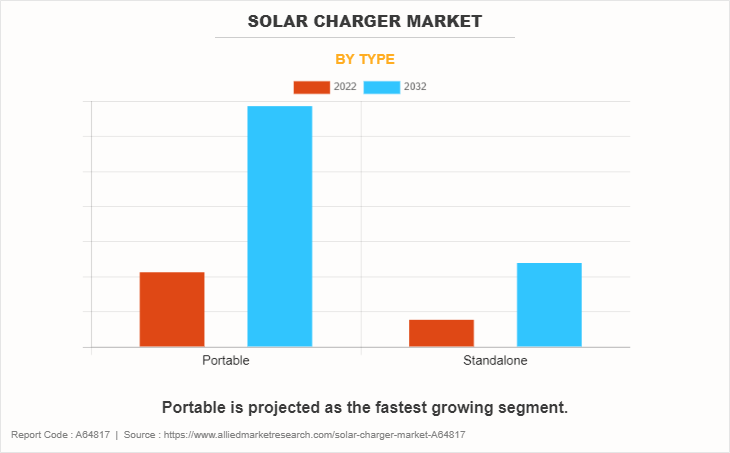
The portable segment accounted for the largest share in 2022 and is expected to register the highest CAGR of 12.6% owing to an increase in demand for on-the-go solutions. The surge in demand for portable devices and products, driven by the need for convenience and flexibility in various applications, contributed to the segment's largest market share.
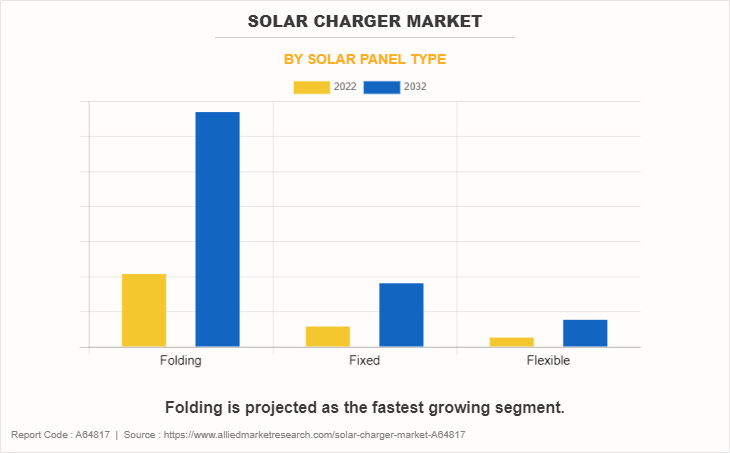
The folding segment accounted for the largest share in 2022 and is expected to register the highest CAGR of 12.6% due to its versatility and compact design. Foldable solar chargers provide portable and effective charging solutions owing to their capacity to offer electricity on-the-go in a portable, space-saving format.
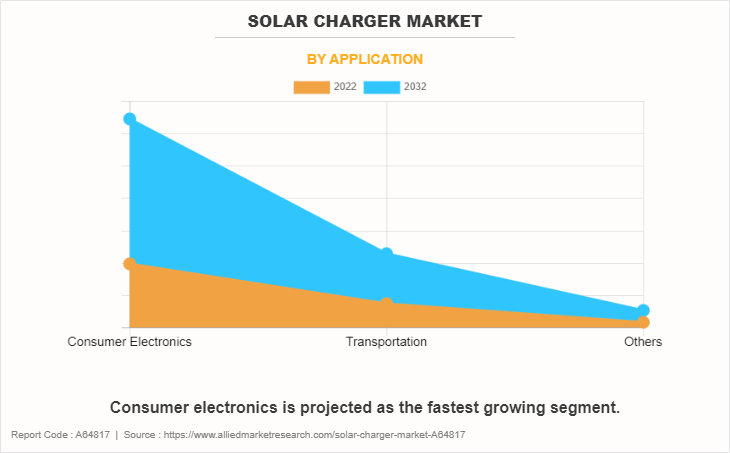
The consumer electronics segment accounted for the largest share in 2022 and is expected to register the highest CAGR of 12.6% driven by increased adoption of renewable energy in electronic devices. Rise in environmental consciousness and the need for sustainable power sources led to a surge in demand for solar chargers, particularly in consumer electronics, contributing to the segment's largest market share.
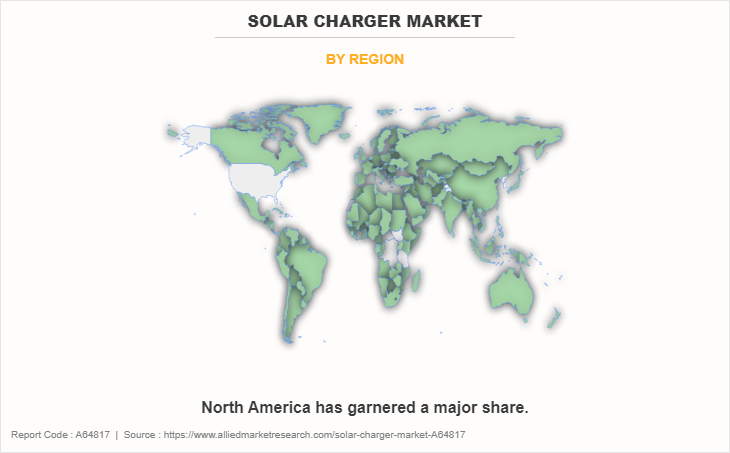
North America garnered the largest share in 2022 owing to an increased focus on renewable energy and sustainable practices. Government initiatives, incentives, and a growing environmentally conscious consumer base propelled the adoption of solar chargers, establishing North America as a prominent region for solar charging solutions.
The major players operating in the global solar charger market are Allpowers Industrial International, Goal Zero, letsolar, RAVPower, Renogy, Secur, Solar Frontier Europe GmbH, Solar Technology International, The NOCO Company, and YOLK.
Other players include Anker, BioLite Inc., Choetech Store, Hanergy Thin Film Power Group Europe, Little Sun, OUTXE, Suntrica, ToughTested, Voltaic Systems, and Xtorm.
Public Policies
Renewable Energy Incentives: India has set an ambitious target of achieving 500 GW of non-fossil fuel-based energy by 2030, which is the world’s largest expansion plan in renewable energy. The country has already achieved its target of 40% installed electric capacity from non-fossil fuels in November 2021. India ranks 4th globally for total renewable power capacity additions and saw the highest year-on-year growth in renewable energy additions of 9.83% in 2022. Up to 100% FDI is allowed under the automatic route for renewable energy generation and distribution projects subject to provisions of The Electricity Act 2003.
Energy Efficiency Standards: According to the International Energy Agency (IEA), energy efficiency is currently seeing a strong global focus among policy makers in recognition of its key role in enhancing energy security and affordability, and in accelerating clean energy transitions. However, the estimated 2023 rate of progress in energy intensity - the main metric used for the energy efficiency of the global economy - is set to fall back below longer-term trends, to 1.3% from a stronger 2% in 2022. The lower energy intensity improvement rate largely reflects an increase in energy demand of 1.7% in 2023, compared with 1.3% a year ago.
Green Procurement Policies: The European Union has implemented Ecodesign and Green Public Procurement regulations to improve the sustainability performance of PV modules and systems. The U.S. government also uses EPEAT, an Ecolabel, to set performance benchmarks for material use in solar chargers.
Net Metering Policies: The Ministry of Power in India has issued an amendment to the Electricity (Rights of Consumers) 2020 Rules concerning net metering for rooftop solar installations. The amendment permits net metering to the prosumer for loads up to 500 kW or up to the sanctioned load, whichever is lower.
Off-Grid Electrification Initiatives: According to the World Bank Group’s initiative, Lighting Global, off-grid solar electricity is key to achieving universal electricity access. As of December 2019, 52.4 million people are meeting their basic electricity needs with Lighting Global quality-verified products.
Grid Interconnection Standards: The Solar Energy Industries Association (SEIA) has published a guideline that provides an overview of the formulas and processes undertaken when designing (or sizing) a Battery Energy Storage System (BESS) connected to a grid-connected PV system.
Key Benefits For Stakeholders
- This report provides a quantitative analysis of the market segments, current trends, estimations, and dynamics of the solar charger market analysis from 2022 to 2032 to identify the prevailing solar charger market opportunities.
- The market research is offered along with information related to key drivers, restraints, and opportunities.
- Porter's five forces analysis highlights the potency of buyers and suppliers to enable stakeholders make profit-oriented business decisions and strengthen their supplier-buyer network.
- In-depth analysis of the solar charger market segmentation assists to determine the prevailing market opportunities.
- Major countries in each region are mapped according to their revenue contribution to the global market.
- Market player positioning facilitates benchmarking and provides a clear understanding of the present position of the market players.
- The report includes the analysis of the regional as well as global solar charger market trends, key players, market segments, application areas, and market growth strategies.
Solar Charger Market Report Highlights
| Aspects | Details |
| Market Size By 2032 | USD 1849 million |
| Growth Rate | CAGR of 12.5% |
| Forecast period | 2022 - 2032 |
| Report Pages | 250 |
| By Type |
|
| By Solar Panel Type |
|
| By Application |
|
| By Region |
|
| Key Market Players | RAVPower, Allpowers Industrial International, the noco company, Solar Technology International, yolk, Goal Zero, Secur., letsolar, renogy-solar, Solar Frontier Europe GmbH |
Analyst Review
According to the insights of the CXOs of leading companies, the global solar charger market is poised for significant growth during the forecast period, driven by increase in demand for renewable energy. urge in usage of portable devices is a key factor propelling market expansion. However, challenges such as high initial costs and irregular nature of solar energy are restraining the market growth.
The CXOs further added that the growing utilization of solar chargers as a sustainable product offers lucrative opportunities for market growth. Moreover, the industry is characterized by a high number of new market entrants that seek to take lucrative opportunities in the global market while existing players enter strategic collaborations to increase capacities and expand their reach into emerging markets.
The global solar charger market was valued at $575 million in 2022, and is projected to reach $1,849 million by 2032, growing at a CAGR of 12.5% from 2023 to 2032.
Rise in demand for sustainable products and decrease in solar panel prices are the upcoming trends of Solar Charger Market in the world.
Consumer electronics, transportation, and solar backups are the leading application of Solar Charger Market
North America is the largest regional market for Solar Charger.
The major players operating in the global solar charger market are Allpowers Industrial International, Goal Zero, letsolar, RAVPower, Renogy, Secur, Solar Frontier Europe GmbH, Solar Technology International, The NOCO Company, and YOLK.
Loading Table Of Content...
Loading Research Methodology...



